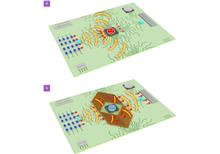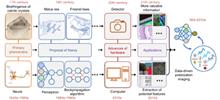 View fulltext
View fulltext
Simultaneously manipulating multiple physical fields plays an important role in the increasingly complex integrated systems, aerospace equipment, biochemical productions, etc. For on-chip systems with high integration level, the precise and efficient control of the propagation of electromagnetic waves and heat fluxes simultaneously is particularly important. In this study, we propose a graphical designing method (i.e., thermal-electromagnetic surface transformation) based on thermal-electromagnetic null medium to simultaneously control the propagation of electromagnetic waves and thermal fields according to the pre-designed paths. A thermal-electromagnetic cloak, which can create a cloaking effect on both electromagnetic waves and thermal fields simultaneously, is designed by thermal-electromagnetic surface transformation and verified by both numerical simulations and experimental measurements. The thermal-electromagnetic surface transformation proposed in this study provides a new methodology for simultaneous controlling on electromagnetic and temperature fields, and may have significant applications in improving thermal-electromagnetic compatibility problem, protecting of thermal-electromagnetic sensitive components, and improving efficiency of energy usage for complex on-chip systems.
This study reviews the recent advances in data-driven polarimetric imaging technologies based on a wide range of practical applications. The widespread international research and activity in polarimetric imaging techniques demonstrate their broad applications and interest. Polarization information is increasingly incorporated into convolutional neural networks (CNN) as a supplemental feature of objects to improve performance in computer vision task applications. Polarimetric imaging and deep learning can extract abundant information to address various challenges. Therefore, this article briefly reviews recent developments in data-driven polarimetric imaging, including polarimetric descattering, 3D imaging, reflection removal, target detection, and biomedical imaging. Furthermore, we synthetically analyze the input, datasets, and loss functions and list the existing datasets and loss functions with an evaluation of their advantages and disadvantages. We also highlight the significance of data-driven polarimetric imaging in future research and development.










